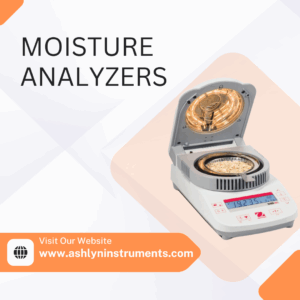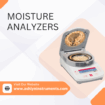Accurate moisture measurement is a key requirement in many industries including food processing, pharmaceuticals, chemicals, agriculture, and textiles. It directly influences product quality, shelf life, and process efficiency. To ensure consistent results and control, many professionals turn to Moisture Analyzers—specialized devices designed to measure the moisture content in various materials. What Are Moisture Analyzers? Moisture analyzers determine the amount of moisture in a sample by heating it to remove water content and calculating the weight loss. These analyzers offer quick, precise, and consistent results, making them essential tools in quality control laboratories and production environments. Used globally across multiple sectors, moisture analyzers help maintain strict quality standards and reduce variability in final products. Whether dealing with food powders, chemicals, or grains, moisture analysis ensures consistency from batch to batch. Types of Moisture Analyzers There are two commonly used types of moisture analyzers in today’s market: Halogen Moisture Analyzers and Infrared Moisture Analyzers. Both serve the same fundamental purpose but differ in their heating technologies and application benefits. Halogen Moisture Analyzers Halogen Moisture Analyzers utilize halogen lamps to heat the sample. This method is known for its speed and efficiency. The intense, even heating provided by the halogen lamp allows for rapid moisture evaporation, making it a preferred choice in environments where fast testing is crucial. The halogen moisture analyzer is widely appreciated for its user-friendly operation and quick turnaround time. It’s ideal for high-throughput production lines, research labs, and anywhere rapid testing is necessary. These analyzers often come with programmable settings, digital displays, and data storage features for ease of use. Key benefits include: Rapid test completion Consistent and uniform heating High accuracy with repeatable results Simple operation and maintenance Infrared Moisture Analyzers Infrared Moisture Analyzers work by using infrared radiation as the heating source. Though slightly slower in drying time compared to halogen models, they offer stable, controlled heating suitable for delicate or sensitive materials. Infrared heating penetrates deeper into some types of samples, offering thorough drying and consistent results over time. These analyzers are typically used in applications where exact moisture levels are critical and test conditions must be closely managed. Advantages include: Accurate and reliable performance Better suited for heat-sensitive or complex samples Long operational life Effective for a wide range of materials Moisture Analyzers in Various Industries Moisture content plays a major role in determining the quality and usability of materials. Here's how different industries benefit from using moisture analyzers: Food Industry: Helps maintain texture, taste, and shelf life by monitoring moisture in ingredients like flour, spices, dairy, and snacks. Pharmaceuticals: Ensures active ingredient stability and dosage accuracy by precisely measuring moisture in powders and tablets. Chemicals: Maintains product consistency and ensures the effectiveness of chemical reactions. Agriculture: Determines seed and grain storage quality by evaluating moisture levels, critical for preventing spoilage. Textiles: Controls the dyeing process and product quality by measuring moisture in fabrics and fibers. In all these fields, moisture analyzers help in achieving regulatory compliance and process control, reducing waste, and improving product performance. Choosing Between Halogen and Infrared Moisture Analyzers Selecting the right moisture analyzer depends on several factors: Speed: If fast results are necessary, halogen moisture analyzers are preferred. Sample Type: Infrared analyzers may be better for heat-sensitive or complex materials. Testing Frequency: For continuous, routine analysis, halogen models offer quicker turnaround. Precision Needs: Both offer precision, but infrared may be slightly more stable over time. The choice between a halogen moisture analyzer and an infrared version should be based on your material type, testing environment, and required level of accuracy. Why Redlands Ashlyn Matters When discussing industrial solutions, the name Redlands Ashlyn is often mentioned for its long-standing expertise in precision equipment for the jewellery, laboratory, and manufacturing sectors. Known for offering robust and accurate measuring solutions, Redlands Ashlyn is a trusted name across many technical domains. Their commitment to quality has made them a go-to provider for tools that support inspection, analysis, and production efficiency. For professionals looking to build a comprehensive testing environment, combining tools like weighing scales from Redlands Ashlyn with advanced moisture analyzers can ensure unmatched precision and reliability in results. Final Thoughts Moisture analysis is a critical part of industrial quality control. Whether you need to prevent spoilage, ensure chemical stability, or maintain textile quality, moisture analyzers—including halogen moisture analyzers and infrared moisture analyzers—play a crucial role in maintaining high production standards. While Redlands Ashlyn may not directly supply moisture analyzers, their presence in the quality control ecosystem highlights the importance of combining dependable tools for best-in-class performance. By selecting the right analyzer and using it alongside proven instruments, manufacturers can boost efficiency, enhance quality, and stay compliant with industry regulations.

